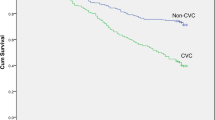Abstract
Background
Cardiac valve calcification is a frequent finding in chronic haemodialysis patients. Left ventricular hypertrophy (LVH) is a significant predictor of cardiovascular mortality in patients with end-stage renal disease. We evaluated the influence of aortic valve sclerosis (AVS) on the development of LVH in chronic haemodialysis patients.
Methods
A total of 82 consecutive patients (52 male, mean age 48 ± 12 years) undergoing chronic haemodialysis treatment for >1 year were subjected to echocardiography for the screening of AVS and the assessment of transaortic flow velocity and the left ventricular mass index (LVMI). The absence (group 1, n = 42) and presence of AVS (group 2, n = 40) was established. The average values of systolic, diastolic and pulse pressure were obtained. Plasma calcium, phosphorus, intact parathyroid hormone, C-reactive protein, haemoglobin and lipid levels were also measured.
Results
LVH was detected in 59 (72%) of the study patients. The LVMI was higher in the AVS group (171 ± 39 vs. 132 ± 41 g/m2, p < 0.001). Patients with AVS also had higher transaortic flow velocities (1.64 ± 0.36 vs. 1.21 ± 0.21 m/s, p < 0.01) and maximal pressure gradients (10.8 ± 7.1 vs. 5.9 ± 3.4 mmHg, p < 0.01). The LVMI showed a direct correlation with transaortic flow velocity in the AVS group (r = 0.60, p < 0.01). Stepwise linear regression analysis revealed transaortic flow velocity (p = 0.02), pulse pressure (p = 0.01) and haemoglobin levels (inverse relationship) (p = 0.02) to be independent predictors of the LVMI.
Conclusion
These data suggest that AVS is strongly and independently interrelated with LVH in chronic haemodialysis patients. The underlying mechanism might be the valve resistance to left ventricular outflow, as shown by increased transaortic flow velocities and maximal pressure gradients in AVS patients.

Similar content being viewed by others
References
Zoccali C, Benedetto FA, Mallamaci F et al (2001) Prognostic impact of the indexation of left ventricular mass in patients undergoing dialysis. J Am Soc Nephrol 12:2768–2774
Paoletti E, Specchia C, Di Maio G et al (2004) The worsening of left ventricular hypertrophy is the strongest predictor of sudden cardiac death in haemodialysis patients: a 10 year survey. Nephrol Dial Transplant 19:1829–1834
London GM (2003) Cardiovascular disease in chronic renal failure: pathophysiologic aspects. Semin Dial 16:85–94
Parfrey PS, Foley RN (1999) The clinical epidemiology of cardiac disease in chronic renal failure. J Am Soc Nephrol 10:1606–1615
Ventura JE, Tavella N, Romero C et al (2002) Aortic valve calcification is an independent factor of left ventricular hypertrophy in patients on maintenance haemodialysis. Nephrol Dial Transplant 17:1795–1801
Maher ER, Pazianas M, Curtis JR (1987) Calcific aortic stenosis: a complication of chronic uraemia. Nephron 47:119–122
Ureña P, Malergue MC, Goldfarb B et al (1999) Evolutive aortic stenosis in hemodialysis patients: analysis of risk factors. Nephrologie 20:217–225
Friedewald WT, Levy RI, Fredrickson DS (1972) Estimation of the concentration of LDL-cholesterol in plasma without use of the preparative ultracentrifuge. Clin Chem 18:499–502
Devereux RB, Reichek N (1977) Echocardiographic determination of left ventricular mass in man. Anatomic validation of the method. Circulation 55:613–618
Dubois D, Dubois EF (1915) The measurement of the surface area of man. Arch Intern Med 16:868–881
Stewart BF, Siscovick D, Lind BK et al (1997) Clinical factors associated with calcific aortic valve disease. Cardiovascular Health Study. J Am Coll Cardiol 29:630–634
Otto CM, Lind BK, Kitzman DW et al (1999) Association of aortic-valve sclerosis with cardiovascular mortality and morbidity in the elderly. N Engl J Med 341:142–147
Maher ER, Young G, Smyth-Walsh B et al (1987) Aortic and mitral valve calcification in patients with end-stage renal disease. Lancet 2:875–877
Straumann E, Meyer B, Misteli M et al (1992) Aortic and mitral valve disease in patients with end stage renal failure on long-term haemodialysis. Br Heart J 67:236–239
Ribeiro S, Ramos A, Brandão A et al (1998) Cardiac valve calcification in haemodialysis patients: role of calcium-phosphate metabolism. Nephrol Dial Transplant 13:2037–2040
Pohle K, Mäffert R, Ropers D et al (2001) Progression of aortic valve calcification: association with coronary atherosclerosis and cardiovascular risk factors. Circulation 104:1927–1932
Kajbaf S, Veinot JP, Ha A et al (2005) Comparison of surgically removed cardiac valves of patients with ESRD with those of the general population. Am J Kidney Dis 46:86–93
Movillia E, Feliciania A, Camerini C et al (2005) A high calcium-phosphate product is associated with high C-reactive protein concentrations in hemodialysis patients. Nephron Clin Pract 101:c161–c167
Torun D, Sezer S, Baltali M et al (2005) Association of cardiac valve calcification and inflammation in patients on hemodialysis. Ren Fail 27:221–226
Klassen PS, Lowrie EG, Reddan DN et al (2002) Association between pulse pressure and mortality in patients undergoing maintenance hemodialysis. J Am Med Assoc 287:1548–1555
Blacher J, Guerin AP, Pannier B et al (1999) Impact of aortic stiffness on survival in end-stage renal disease. Circulation 99:2434–2439
London GM, Marchais SJ, Safar ME et al (1990) Aortic and large artery compliance in end-stage renal failure. Kidney Int 37:137–142
Yıldız A, Memisoglu E, Oflaz H et al (2005) Atherosclerosis and vascular calcification are independent predictors of left ventricular hypertrophy in chronic haemodialysis patients. Nephrol Dial Transplant 20:760–767
Amann K, Rychlik I, Miltenberger-Mitteny G et al (1998) Left ventricular hypertrophy in renal failure. Kidney Int 54(Suppl 68):S78–S85
Meeus F, Kourilsky O, Guerin AP et al (2000) Pathophysiology of cardiovascular disease in hemodialysis patients. Kidney Int 58(Suppl 76):S140–S147
Author information
Authors and Affiliations
Corresponding author
Rights and permissions
About this article
Cite this article
Turkmen, F., Emre, A., Ozdemir, A. et al. Relationship between aortic valve sclerosis and left ventricular hypertrophy in chronic haemodialysis patients. Int Urol Nephrol 40, 497–502 (2008). https://doi.org/10.1007/s11255-007-9317-4
Received:
Accepted:
Published:
Issue Date:
DOI: https://doi.org/10.1007/s11255-007-9317-4




